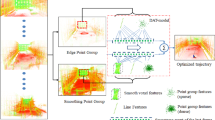Abstract
In order to obtain the fast three-dimensional surface reconstruction from given scattered point clouds, a novel improved point-cloud surface reconstruction algorithm for laser imaging radar is proposed so as to reconstruct the three-dimensional depth surface from the depth data and image data in this paper. Firstly, the three-dimensional space is partitioned into voxels with local distance points and finds outliers with point histogram features; then the Gaussian process (GP) regression is adopted to generate a plane similar to a Gaussian distribution; finally, the high-resolution gray data and three-dimensional interpolation points are fused by using Markov random fields to build a dense three-dimensional depth surface. Experimental results show that our proposed algorithm will greatly improve the robustness and reconstruction accuracy of three-dimensional surface reconstruction algorithm and can be used to assist unmanned driving in complex urban scenes.





Similar content being viewed by others
References
Bassier M, Klein R, Van Genechten B, et al. (2018) IFC Wall reconstruction from unstructured point clouds[C]//annals of the photogrammetry remote sensing and spatial information sciences
Chan D, Buisman H et al. (2008) A noise-aware filter for real-time depth upsampling, Workshop on Multi-camera and Multi-modal Sensor Fusion Algorithms and Applications-M2SFA2 2008
Diebel and Thrun S (2005) An application of markov random fields to range sensing, in Advances in neural information processing systems, pp. 291–298
Dolson J, Baek J, Plagemann C, Thrun S (2010) Upsampling range data in dynamic environments. Computer vision and pattern recognition (CVPR), 2010 IEEE conference on. IEEE, pp. 1141–1148
Foix S, Alenya G, Torras C (2011) Lock-in time-of-flight (tof) cameras: a survey. Sensors Journal IEEE 11(9):1917–1926
Guarda AFR, Bioucas-Dias JM, Rodrigues NMM et al. (2017) Improving point cloud to surface reconstruction with generalized Tikhonov regularization[C]//multimedia signal processing, 2017 IEEE 19th International Workshop on IEEE: 1–6
Harrison A, Newman P (2010) Image and sparse laser fusion for dense scene reconstruction, Field and Service Robotics Springer, pp. 219–228
Jinghao Y, Wei L, Yang L et al (2016) Calibration of binocular stereo vision measurement system[J]. Opt Precis Eng 24(2):300–308
Kósa B, Haličková-Brehovská J, Mikula K. (2017) New efficient numerical method for 3D point cloud surface reconstruction by using level set methods[C]//proceedings of Equadiff 2017 Conference: 387–396
Lin CH, Kong C, Lucey S (2017) Learning efficient point cloud generation for dense 3D object reconstruction[J] arXiv preprint arXiv:1706.07036
Lu J, Min D, Pahwa RS, and Do MN (2011) A revisit to mrf-based depth map super-resolution and enhancement. Acoustics, IEEE International Conference on Speech and Signal Processing (ICASSP), pp. 985–988
Mineo C, Pierce SG, Summan R. (2018) Novel algorithms for 3D surface point cloud boundary detection and edge reconstruction[J]. Journal of Computational Design and Engineering
Rijin Z (2014) Research and implementation of obstacle detection system based on binocular stereo vision [D]. Guilin University of. Electron Technol
Schoenberg JR, Nathan A, Campbell M (2010) Segmentation of dense range information in complex urban scenes. Intelligent robots and systems (IROS), 2010 IEEE/RSJ international conference on. IEEE, pp. 2033–2038
Shuo H, Xiaochong T, Xueliang L et al (2016) Extraction algorithm of motion lines in three-dimensional reconstruction of hand-held laser scanning video[J]. Computer Applications and Software 33(7):154–158
Yugang L, Zhuojun W, Fujing W et al (2016) Measurement method for reversing environmental obstacles based on binocular stereo vision[J]. Journal of Transportation Systems Engineering and Information 16(4):79–87
Zhang A, Li W, Duan Y et al (2016) Point Cloud Classification Method Based on Feature Point Histogram[J]. Journal of Computer-Aided Design & Computer Graphics 28(5):795–801
Zhu J, Yang R (2010) Spatial-temporal fusion for high accuracy depth maps using dynamic mrfs. IEEE Trans Pattern Anal Mach Intell 32(5):899–909
Author information
Authors and Affiliations
Corresponding author
Additional information
Publisher’s Note
Springer Nature remains neutral with regard to jurisdictional claims in published maps and institutional affiliations.
Rights and permissions
About this article
Cite this article
Wang, W. A novel rapid point-cloud surface reconstruction algorithm for laser imaging radar. Multimed Tools Appl 78, 8737–8749 (2019). https://doi.org/10.1007/s11042-018-6244-6
Received:
Revised:
Accepted:
Published:
Issue Date:
DOI: https://doi.org/10.1007/s11042-018-6244-6




